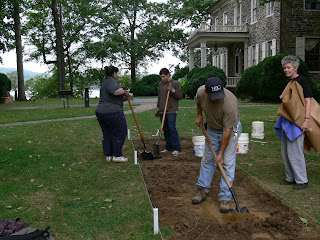 Close-up of fire cracked rock hearth feature
Close-up of fire cracked rock hearth feature
On Monday, September 27, weather permitting; we will bisect the well by excavating the western half. The top of the well measures a little over six feet across so we will only be excavating a three-foot wide section. The process will begin by removing the capping stones (only on the western half). Some of these cap stones were emplaced with mortar. Below the capping stones there are a series of pebble layers that extend to at least three feet below the surface. The pebble layer directly below the capping stones seems to represent a buried humus level or “A” horizon. A buried horizon is a term archaeologists apply to land surfaces that can be recognized often by a darker soil color created by the break down of organic plant materials, thus creating a humus level. This evidence of a humus layer leads us to believe that this level may have been the top of the well for some time prior to the placement of the capping stones. Artifacts recovered within this layer will aid in establishing a date for this level.

The excavation will be conducted in arbitrary levels within cultural levels. All of the material from these excavations will be screened. The top of the well shaft will be excavated in six-inch arbitrary levels, meaning we will measure our excavation levels as we progress and record our findings in these six-inch designations. In 2008, the well shaft was augured to a depth of over eight feet, this test contained early twentieth century artifacts. Typically, when wells are no longer used for water, they are treated like trash dumps until they are filled. If the stratigraphy becomes more complicated with depth, we will need to adjust our strategy.
A big unknown is the total depth of the well and we hope this can be determined with additional auguring. Based on the height of the site above Fishing Creek, the well may be thirty feet deep. Excavating to that depth would be a very difficult engineering feat let alone a complicated archaeological excavation. This season, we hope to get down to at least nine feet. For safety purposes, a deeper excavation will require us to step back the excavation or begin shoring. All of these issues will factor into the excavation which could potentially get very complicated and expensive.
We are hoping the rewards are worth the effort. The well at Fort Loudoun in Franklin County contained the bucket but also rare leather goods such as shoes and boots.
 Oak bucket recovered from excavations at Fort Loudoun
Oak bucket recovered from excavations at Fort LoudounNo matter how this all turns out, by the end of next week, we should have a much better idea of how the well was constructed, its age and the appropriate excavation procedure for next year. We have had a lot of help this fall from volunteers and students at Franklin & Marshall College. Thanks also goes to local channel News 8 for covering our excavations this week and to all of you who visited the site for Fort Hunter Day on September 19th, we enjoy speaking with you and sharing our enthusiasm for this project.
 Fort Hunter Day crowds gather to observe excavations and ask questions of Dr. Kurt Carr.
Fort Hunter Day crowds gather to observe excavations and ask questions of Dr. Kurt Carr.

Excavations continue on the east side of the mansion looking for evidence of the fort with assistance from Franklin and Marshall College students and volunteers.
With any luck we should also have an impressive hole in the ground, which is always a sight to see.
Come visit us at Fort Hunter and stay tuned for updates on our adventure into the past.









